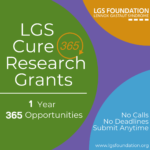2024 Grant Recipients- Juliet Knowles & Zach Grinspan
Identifying Risk Factors for the Progression of Infantile Epileptic Spasm Syndrome (IESS) to LGS

Juliet Knowles, MD, PhD
Stanford University School of Medicine

Zach Grinspan, MD, MS
Weill Cornell School of Medicine
Highlights:
- Up to 50% children with Infantile Epileptic Spasm Syndrome (IESS) will develop LGS in 1-2 years.
- Identification of children with higher risk who develop LGS after IESS will help to develop therapies to prevent LGS onset.
- The Pediatric Epilepsy Learning Health System (PELHS) has harmonized medical records for 487,000 children with history of seizures or epilepsy from 20 academic medical centers.
- The purpose of this study is use PELHS to identify risk factors and predict progression to LGS in a cohort of children with history of IESS.
Results: Grant in Progress
Results will be shared when the grant is completed.
Lay Abstract:
Lennox-Gastaut Syndrome (LGS) is a severe form of epilepsy that begins in childhood and is associated with lifelong treatment-refractory seizures and disability. LGS often follows another severe form of epilepsy that occurs in infancy, infantile epileptic spasms syndrome (IESS). Up to 50% of children with IESS will develop LGS after 1-2 years. If we could identify children at highest risk to develop LGS after IESS, we could develop and test therapies aimed at preventing LGS.
Previously, studies carried out at single academic institutions identified some potential factors, related to causes of and treatments for IESS, that are associated with the subsequent development of LGS. Multi-center studies are needed to validate these potential risk factors, in order to lay the foundation for clinical trials focused on preventing LGS after IESS. In this proposal, we will use a recently developed resource, The Pediatric Epilepsy Learning Health System (PELHS), led by PI Grinspan. PELHS has harmonized medical records for 487,000 children with history of seizures or epilepsy from 20 academic medical centers in the United States. We will use PELHS to identify risk factors and predict progression to LGS in a cohort of children with history of IESS.
Aim 1: determine which search terms most accurately identify children with LGS.
Aim 2: apply these search terms to a cohort of children in the PELHS data set who had IESS, to identify those who later developed LGS. We will then determine which individual factors, related to causes of and treatments for IESS, predict progression to LGS.
Aim 3: develop a statistical model that can predict which children who had IESS are at highest risk of LGS.
These studies will provide information needed for future clinical trials focused on preventing the development of LGS in children who are at the highest risk.
 The LGS Foundation accepts unsolicited proposals year-round to seed new basic, translational, and clinical research projects on LGS. Projects may be funded at the $25,000, $50,000, or $75,000 level.
The LGS Foundation accepts unsolicited proposals year-round to seed new basic, translational, and clinical research projects on LGS. Projects may be funded at the $25,000, $50,000, or $75,000 level.
Updated 01/09/25 (KK)
